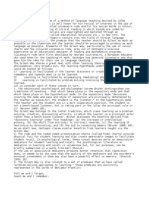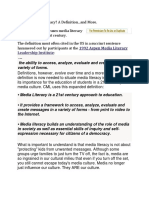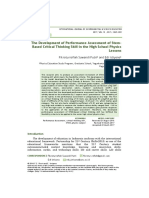TOPIC 1 - Language - and - Communication PDF
Uploaded by
devvy anneTOPIC 1 - Language - and - Communication PDF
Uploaded by
devvy anneLanguage and Communication
Characteristics of Language
Language is dynamic and evolves through time.
Wherever humans exist, language exists.
All languages are equally complex and equally capable of expressing any idea
in the universe.
All languages change through time.
The relationships between the sounds and meanings of spoken languages and
between the gestures and meanings of sign languages are for most part,
arbitrary.
All grammars contain rules for the formation of words and sentences of
similar kind.
Every spoken language includes discrete sound segments that can all be
defined by finite set of sound properties or features.
Similar grammatical categories are found in all languages
Every language has a way of referring to past time, negating, forming
questions, etc.
Language is primarily oral and any normal child born anywhere in the world of
any racial, geographical, social or economic heritage is capable of learning
any language to which he or she is exposed to.
Forms of Communication
Intrapersonal communication is a communication which happens yourself. Here
both Source (sender) and receiver is only one. so, the feedback works without
any interruption. Example: A person can communicate himself through pain,
thinking, feelings and emotion etc.
Small group communication has more than two members involved in
communication process will become a group communication. If least number of
persons is involved in the group communication is called as small group
communication. In this communication process, everyone becomes a Source as
well as receiver through sharing information and gives feedback to another.
Dyadic communication, two persons are involved in this communication process.
Here the Source becomes a receiver and receiver become Source because of
dynamic communication process were the feedback’s are shared between Source
and the receiver.
Language and Communication 1
Public communication has source or messages from a single person will reach or
received by huge number of audience. But in this communication there is no
mutual feedbacks between source and receiver like small group communication
and it’s only focused on Speaker.
Mass communication basically has a large number of audience and they are all
can’t grouped together in one place so we need certain tool or technology for
communication process. But in mass communication, there is no direct access
with receiver. So, for that they need media like newspaper, radio, television and
internet. Here the audience feedback is very less or delayed.
Elements of Communication
Communication Process Definition
The term communication process refers to the exchange of information
(a message) between two or more people. For communication to succeed, both
parties must be able to exchange information and understand each other. If the
flow of information is blocked for some reason or the parties cannot make
themselves understood, then communication fails.
The Sender
The communication process begins with the sender, who is also called
the communicator or source. The sender has some kind of information — a
command, request, question, or idea — that he or she wants to present to others.
For that message to be received, the sender must first encode the message in a
form that can be understood, such as by the use of a common language or
industry jargon, and then transmit it.
The Receiver
Language and Communication 2
The person to whom a message is directed is called the receiver or
the interpreter. To comprehend the information from the sender, the receiver must
first be able to receive the sender's information and then decode or interpret it.
The Message
The message or content is the information that the sender wants to relay to the
receiver. Additional subtext can be conveyed through body language and tone of
voice. Put all three elements together — sender, receiver, and message — and
you have the communication process at its most basic.
The Medium
Also called the channel, the medium is the means by which a message is
transmitted. Text messages, for example, are transmitted through the medium of
cell phones.
Feedback
The communication process reaches its final point when the message has been
successfully transmitted, received, and understood. The receiver, in turn,
responds to the sender, indicating comprehension. Feedback may be direct, such
as a written or verbal response, or it may take the form of an act or deed in
response (indirect).
Other Factors
The communication process isn't always so simple or smooth, of course. These
elements can affect how information is transmitted, received, and interpreted:
Noise: This can be any sort of interference that affects the message being
sent, received, or understood. It can be as literal as static over a phone line or
radio or as esoteric as misinterpreting a local custom.
Context: This is the setting and situation in which communication takes place.
Like noise, context can have an impact on the successful exchange of
information. It may have a physical, social, or cultural aspect to it. In a private
conversation with a trusted friend, you would share more personal
information or details about your weekend or vacation, for example, than in a
conversation with a work colleague or in a meeting.
The Communication Process in Action
Brenda wants to remind her husband, Roberto, to stop by the store after work
and buy milk for dinner. She forgot to ask him in the morning, so Brenda texts a
reminder to Roberto. He texts back and then shows up at home with a gallon of
milk under his arm. But something's amiss: Roberto bought chocolate milk when
Brenda wanted regular milk.
Language and Communication 3
In this example, the sender is Brenda. The receiver is Roberto. The medium is
a text message. The code is the English language they're using. And the message
itself is "Remember the milk!" In this case, the feedback is both direct and
indirect. Roberto texts a photo of milk at the store (direct) and then came home
with it (indirect). However, Brenda did not see the photo of the milk because the
message didn't transmit (noise) and Roberto didn't think to ask what kind of milk
(context).
Essentials of Oral Communication
Competence in oral communication is also important because it makes you
become an effective leader: one who is able to:
1. listen attentively to identify the conveyed meaning
2. collaborate with others
3. use critical thinking and problem solving skills
4. give appropriate feedback
5. converse with others of different backgrounds
These are qualities that are relevant in the present 21st Century World.
1. Methods of Speech delivery / Types of Speech
Methods of delivery refer to the style of delivery.
1. Manuscript - delivered by speakers who intend to read aloud their speech word
for word to their audience.
Example: Writing or reading a proclamation paper, public announcement or
court decision.
2. Memorized - delivered by speakers who intend to memorize their speech word
for word. It is usually written by or by speakers who are inexperienced or
uncomfortable in public speaking
Example: Declamation, oration
3. Impromptu Speech - delivered by speakers who are suddenly asked or
requested by someone or a group of people to say a few words about
something.
Example: Sharing with the class about your experience, idea, prior knowledge,
requested by an emcee to give a birthday wish
4. Extemporaneous Speech - delivered by speakers who intend to present a well-
crafted speech. This speech is fully prepared and perfectly rehearsed ahead of
time.
Example: Giving an inspirational talk to the graduates
2. Components of a Speech
I. Introduction
Language and Communication 4
a. Attention getter
b. Initial summary
c. Speaker's credibility (telling the audience why you are the right person to
talk about the subject)
d. Relevance of the topic to the audience(stating what's in or objectives for
the audience)
e. Self introduction OPTIONAL
f. Thesis Statement
II. Body
a. Main Idea - 2 supporting details ex. cause and effect
b. Main Idea- 2 supporting details ex. similarities and differences
c. Main Idea- 2 supporting details ex. advantages and disadvantages
d. Main Idea- 2 supporting details ex. process and product
Visualization- time to note the positive and negative consequences of your
topic
III. Conclusion
a. Closure- letting your audience know that you are about to end your speech
b. Summary
c. Call to action
d. Powerful closing statement - What the audience will remember at the end of
your speech
Language and Communication 5
You might also like
- LIDDICOAT - Five Principles of Intercultural Language Learning100% (1)LIDDICOAT - Five Principles of Intercultural Language Learning2 pages
- The Principles of Language Teaching and Learning - Group 5 (5B)No ratings yetThe Principles of Language Teaching and Learning - Group 5 (5B)16 pages
- A Guide to the Teaching of English for the Cuban Context IFrom EverandA Guide to the Teaching of English for the Cuban Context I3/5 (2)
- The Factors That Influence The Acquisition of A Second LanguageNo ratings yetThe Factors That Influence The Acquisition of A Second Language2 pages
- Self-Study Project Intrinsic and Extrinsic MotivationNo ratings yetSelf-Study Project Intrinsic and Extrinsic Motivation7 pages
- LISTENING (Harmer, Ur, Scrivener) RESUMENNo ratings yetLISTENING (Harmer, Ur, Scrivener) RESUMEN11 pages
- A Consciousness Raising Approach To The Teaching of Grammar1No ratings yetA Consciousness Raising Approach To The Teaching of Grammar115 pages
- Psychology of Language Teachers (Summary Chapter One)No ratings yetPsychology of Language Teachers (Summary Chapter One)33 pages
- Robert Gagné's Instructional Design ApproachNo ratings yetRobert Gagné's Instructional Design Approach15 pages
- Applied Linguistics and Educational Linguistics: Santi AndriyaniNo ratings yetApplied Linguistics and Educational Linguistics: Santi Andriyani6 pages
- Teaching of English Language Through Group Work in Large ClassesNo ratings yetTeaching of English Language Through Group Work in Large Classes85 pages
- Wallace.M.Training Foreign Language TeachersNo ratings yetWallace.M.Training Foreign Language Teachers14 pages
- The Learning Environment Is Supportive and ProductiveNo ratings yetThe Learning Environment Is Supportive and Productive8 pages
- Cross Cultural Communication and Intercultural CommunicationNo ratings yetCross Cultural Communication and Intercultural Communication8 pages
- I. Difference of Jug and Mug Approach and Carrot and Stick Approach100% (1)I. Difference of Jug and Mug Approach and Carrot and Stick Approach4 pages
- Guide for the development and implementation of curricula for plurilingual and intercultural educationFrom EverandGuide for the development and implementation of curricula for plurilingual and intercultural educationNo ratings yet
- Progressive Education In Nepal: The Community Is the CurriculumFrom EverandProgressive Education In Nepal: The Community Is the CurriculumNo ratings yet
- English as a Language of Teaching and Learning for Community Secondary Schools in Tanzania: A Critical AnalysisFrom EverandEnglish as a Language of Teaching and Learning for Community Secondary Schools in Tanzania: A Critical AnalysisNo ratings yet
- Patricia and Bella Sari-Sari Store': Economic FactorsNo ratings yetPatricia and Bella Sari-Sari Store': Economic Factors2 pages
- TOPIC 2 - Communication Across Professions PDF100% (1)TOPIC 2 - Communication Across Professions PDF3 pages
- TOPIC 2 - Communication Across Professions PDF100% (1)TOPIC 2 - Communication Across Professions PDF3 pages
- AI vs. Human - Differentiation Analysis of Scientific Content GenerationNo ratings yetAI vs. Human - Differentiation Analysis of Scientific Content Generation18 pages
- The Linguistics of Second Language Acquisition: Sar BoNo ratings yetThe Linguistics of Second Language Acquisition: Sar Bo10 pages
- Wake County Schools IEP Document: C: EC File, Parent/Guardian Student UID#: 9294965, Page: 1No ratings yetWake County Schools IEP Document: C: EC File, Parent/Guardian Student UID#: 9294965, Page: 110 pages
- Auditing Operating Systems Networks: Security Part 1: andNo ratings yetAuditing Operating Systems Networks: Security Part 1: and24 pages
- Germs, Malaria and The Invention of Mansonian Tropical Medicine: From 'Diseases in The Tropics' To 'Tropical Diseases'No ratings yetGerms, Malaria and The Invention of Mansonian Tropical Medicine: From 'Diseases in The Tropics' To 'Tropical Diseases'27 pages
- Black and Blue 3D and Futuristic Pitch Deck PresentationNo ratings yetBlack and Blue 3D and Futuristic Pitch Deck Presentation30 pages
- Industrial Employment (Standing Orders) Act, 1946100% (1)Industrial Employment (Standing Orders) Act, 194624 pages
- A Study On Consumer Satisfaction Towards E - Banking" With Special Reference To Syndicate Bank, Vidya Nagara, ShivamoggaNo ratings yetA Study On Consumer Satisfaction Towards E - Banking" With Special Reference To Syndicate Bank, Vidya Nagara, Shivamogga55 pages
- The Prisoner of Beauty - The Marquise Is Innocent - 101 - EndNo ratings yetThe Prisoner of Beauty - The Marquise Is Innocent - 101 - End810 pages
- B.Tech Final Year Project On AUTONOMOUS PARALLEL PARKING RC CAR100% (1)B.Tech Final Year Project On AUTONOMOUS PARALLEL PARKING RC CAR11 pages
- Derrick Rose': Valerio, Cyrus Steven E. Bsma-1A Arts AppreciationNo ratings yetDerrick Rose': Valerio, Cyrus Steven E. Bsma-1A Arts Appreciation2 pages
- Corina V Makore Final Dissertation PDF DocumentNo ratings yetCorina V Makore Final Dissertation PDF Document81 pages
- LIDDICOAT - Five Principles of Intercultural Language LearningLIDDICOAT - Five Principles of Intercultural Language Learning
- The Principles of Language Teaching and Learning - Group 5 (5B)The Principles of Language Teaching and Learning - Group 5 (5B)
- A Guide to the Teaching of English for the Cuban Context IFrom EverandA Guide to the Teaching of English for the Cuban Context I
- The Factors That Influence The Acquisition of A Second LanguageThe Factors That Influence The Acquisition of A Second Language
- Self-Study Project Intrinsic and Extrinsic MotivationSelf-Study Project Intrinsic and Extrinsic Motivation
- A Consciousness Raising Approach To The Teaching of Grammar1A Consciousness Raising Approach To The Teaching of Grammar1
- Psychology of Language Teachers (Summary Chapter One)Psychology of Language Teachers (Summary Chapter One)
- Applied Linguistics and Educational Linguistics: Santi AndriyaniApplied Linguistics and Educational Linguistics: Santi Andriyani
- Teaching of English Language Through Group Work in Large ClassesTeaching of English Language Through Group Work in Large Classes
- The Learning Environment Is Supportive and ProductiveThe Learning Environment Is Supportive and Productive
- Cross Cultural Communication and Intercultural CommunicationCross Cultural Communication and Intercultural Communication
- I. Difference of Jug and Mug Approach and Carrot and Stick ApproachI. Difference of Jug and Mug Approach and Carrot and Stick Approach
- Guide for the development and implementation of curricula for plurilingual and intercultural educationFrom EverandGuide for the development and implementation of curricula for plurilingual and intercultural education
- Progressive Education In Nepal: The Community Is the CurriculumFrom EverandProgressive Education In Nepal: The Community Is the Curriculum
- English as a Language of Teaching and Learning for Community Secondary Schools in Tanzania: A Critical AnalysisFrom EverandEnglish as a Language of Teaching and Learning for Community Secondary Schools in Tanzania: A Critical Analysis
- Patricia and Bella Sari-Sari Store': Economic FactorsPatricia and Bella Sari-Sari Store': Economic Factors
- AI vs. Human - Differentiation Analysis of Scientific Content GenerationAI vs. Human - Differentiation Analysis of Scientific Content Generation
- The Linguistics of Second Language Acquisition: Sar BoThe Linguistics of Second Language Acquisition: Sar Bo
- Wake County Schools IEP Document: C: EC File, Parent/Guardian Student UID#: 9294965, Page: 1Wake County Schools IEP Document: C: EC File, Parent/Guardian Student UID#: 9294965, Page: 1
- Auditing Operating Systems Networks: Security Part 1: andAuditing Operating Systems Networks: Security Part 1: and
- Germs, Malaria and The Invention of Mansonian Tropical Medicine: From 'Diseases in The Tropics' To 'Tropical Diseases'Germs, Malaria and The Invention of Mansonian Tropical Medicine: From 'Diseases in The Tropics' To 'Tropical Diseases'
- Black and Blue 3D and Futuristic Pitch Deck PresentationBlack and Blue 3D and Futuristic Pitch Deck Presentation
- A Study On Consumer Satisfaction Towards E - Banking" With Special Reference To Syndicate Bank, Vidya Nagara, ShivamoggaA Study On Consumer Satisfaction Towards E - Banking" With Special Reference To Syndicate Bank, Vidya Nagara, Shivamogga
- The Prisoner of Beauty - The Marquise Is Innocent - 101 - EndThe Prisoner of Beauty - The Marquise Is Innocent - 101 - End
- B.Tech Final Year Project On AUTONOMOUS PARALLEL PARKING RC CARB.Tech Final Year Project On AUTONOMOUS PARALLEL PARKING RC CAR
- Derrick Rose': Valerio, Cyrus Steven E. Bsma-1A Arts AppreciationDerrick Rose': Valerio, Cyrus Steven E. Bsma-1A Arts Appreciation



































































































